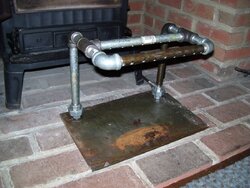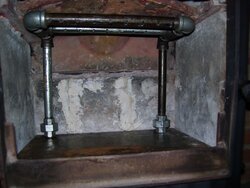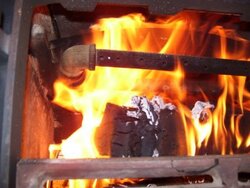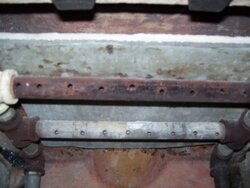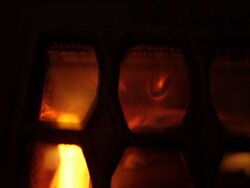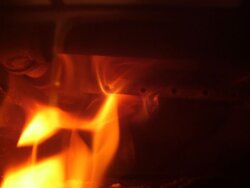I have a Coalbrookdale - Much Wenlock coal/wood stove (English import). Over the last 25 years I have been burning nut coal and occasionally wood. The stove is in excellent shape but I have switched to burning more wood and feel that the combo design does not do well for efficient wood burning. I decided to make some modifications with two goals in mind, increase wood burning efficiency and avoid modifications that could not be reversed if it didn't work out. First step was to lift out the shaker grates and replace them with a solid steel plate. This plate sits across the bottom of the stove over the ash tray. Intake air enters the stove through a control on the ash pan door. Second step was to install secondary burn tubes along the top baffle. Air feed to these tubes is from under the steel plate, utilizing the air entering through the ash pan door. This modification was fairly easy to do using 1/2 inch threaded steel pipe. No permanent changes were made to the stove itself. You can see from the pictures it is a free standing insert so I could easily convert the stove back to coal burning. I fired it up last night and had mixed results. The wood now burns in it's ash and gives me a longer burn per load. The disappointment was the secondary burn tubes. I could only see one of the air holes on the burn tubes producing flames. It was the middle air hole on the tube, hottest spot. My guess is there is not enough air coming up and out of the burn tubes. Both the firebox and burn tubes share the air entering in under the steel plate. I have no way to control how much air goes to each component. Does anyone have additionhal thoughts on what may be happening here? Any suggestions for improvement would be appreciated.
Wood Stove Modifications
- Thread starter Backwoodsman
- Start date
-
Active since 1995, Hearth.com is THE place on the internet for free information and advice about wood stoves, pellet stoves and other energy saving equipment.
We strive to provide opinions, articles, discussions and history related to Hearth Products and in a more general sense, energy issues.
We promote the EFFICIENT, RESPONSIBLE, CLEAN and SAFE use of all fuels, whether renewable or fossil.
You are using an out of date browser. It may not display this or other websites correctly.
You should upgrade or use an alternative browser.
You should upgrade or use an alternative browser.
- Status
- Not open for further replies.
ControlFreak
Feeling the Heat
Keep in mind that the top baffle should be as close to the burn tubes as possible. That baffle should be a very light material that can heat up and glow red. It will serve as a source of ignition for the injected air mixed with rising smoke. It also concerns me that the the vertical pipes may be too small.
branchburner
Minister of Fire
You might add a layer of thin bricks to the floor of the firebox (or just let the ash build much deeper as a test) to insulate the steel plate and bring the fire closer to the tubes. With EPA stoves, the baffle above the tubes is typically insulated above to concentrate the heat below, and prevent too much of it from radiating up and through the top of the stove, so you might try doing that.
If neither of those methods help, try calling a plumber.
If neither of those methods help, try calling a plumber.
Thanks for the advice. I have noticed that new stoves keep the baffle against the burn tubes. I can easily add a metal plate on top of the tubes. I was wondering if I should make the baffle bigger than the one that is there now. This would delay the escape of gases so they could burn. I have room to put some tyoe of insulation material on top of the baffle, but not sure what to use. I did a second burn and got better results by burning a bigger load and letting it run hotter. When the stove reached 350, I got flames streaming from most of the air holes. The flames were not consistant, they would start and stop. I think this was caused by air turbulance. This may be reslolved when I add the baffle.
branchburner
Minister of Fire
Backwoodsman said:I have room to put some tyoe of insulation material on top of the baffle, but not sure what to use.
Probably kaowool blanket is easiest, or ceramic fiber board?
https://www.hearth.com/econtent/index.php/forums/viewthread/59773/
kgrant
Member
I like it! Simple design!
I would try a piece of plate steel on top of the air tubes. And give about 3-4" in the front for the smoke to flow up. On my Englander NC-30, 350* is awful cold to be getting secondarys lit.
Let us know how it turns out!
I would try a piece of plate steel on top of the air tubes. And give about 3-4" in the front for the smoke to flow up. On my Englander NC-30, 350* is awful cold to be getting secondarys lit.
Let us know how it turns out!
ControlFreak
Feeling the Heat
Backwoodsman said:Thanks for the advice. I have noticed that new stoves keep the baffle against the burn tubes. I can easily add a metal plate on top of the tubes.
The performance of your secondary combustion will be sigificantly improved if you use a light ceramic material for your baffle. An alternative may be thin stainless steel sheet metal, since I think it's more able to tolerate the high temps without deformation. The thing is, you want to be able to heat up that baffle easily.
branchburner
Minister of Fire
ControlFreak said:The thing is, you want to be able to heat up that baffle easily.
Heat up quick, but also insulate above, so it stays hot. The "light ceramic" should be the insulator, it should not be the baffle itself - that should be steel, yes?
ControlFreak
Feeling the Heat
branchburner said:ControlFreak said:The thing is, you want to be able to heat up that baffle easily.
Heat up quick, but also insulate above, so it stays hot. The "light ceramic" should be the insulator, it should not be the baffle itself - that should be steel, yes?
I don't think it matters all that much whats above. I know that some stoves use a ceramic blanket on top of the baffle. I can't speak to that since I don't have any direct experience with that. I just know that replacing standard firebricks in the top of my 1401 with the newer light refractory panels made a huge improvement in the way the stove runs. Also, the HI300 that I bought recently (and haven't had the time to install), uses very light refractory panels for the baffle. So I don't see any need for a steel plate being needed in the baffle. The fun thing about this is that its reasonably easy to experiment with since the baffle just sits in there without much need for being screwed in.
branchburner
Minister of Fire
ControlFreak said:The fun thing about this is that its reasonably easy to experiment with since the baffle just sits in there without much need for being screwed in.
True enough. I suppose the standard is steel, with the lighter refractory above, because the steel can take more punishment. As long as it's not a heat sink like the bricks.
After reviewing all the great advice, I made a baffle today. I decided to try ceramic over steel so I rummaged through my spare parts pile and found a large ceramic tile and a piece of sheet metal. I cut them to size and placed over the burn tubes with the metal facing down. I extended the baffle further to the front than the original one in the stove. My thoughts were to slow the escape of gases. I could aways shorten if it created a problem. I gave it a test and was amazed at the improvement. This stove has never burned so clean. The glass stayed crystal clear as colorful flames swirled. I had lots of flames coming from the burn tubes. I was also impressed with the temperature difference between the front of the stove and the stack pipe. The stove surface was 550F while the stack was 295F. I believe the baffle was doing a good job of keeping more heat in the stove. I am confident that my $25. investment in this upgrade will payback big time. Thanks for every ones advice, this forum is a wonderful resource.
Attachments
branchburner
Minister of Fire
Ceramic tile is not the same as ceramic insulation blanket. I suspect there would be little difference with the tile in there or not. But the baffle should be an improvement regardless. Does it fit tightly to the back of the stove? If not, a blanket will conform to the back better and will help seal off the back edge better.
Beetle-Kill
Minister of Fire
Gotta love prototyping. I used 1/2" steel plate for my baffle, with fire brick on top. Sucked to install, but once in place worked better than hoped for. Backwoodsman, try this- upgrade your sheetmetal to 3/16", add firebrick to the top(back-to-front), and then use a sliding baffle plate(14g. steel) with a 45 degree bend about 1" long as the leading edge. The main length of the slider will be determined by your stove(I have no clue), but the width should be as wide as you can fit in there. The reason for the "slider" is that you will be able to go in-&-out with the light guage steel, to control exhaust gas escape. When you get smoke rolling out with an open door, scootch the slider in a few bit's (1/16"=1bit). Allows a easier path for the exhaust gass(smoke). You'll eventually replace the plate with something sturdier, but by then you'll have a good idea of the direction you want to go. Love your design, simple yet effective.
Here are two pictures I took.branchburner said:Nice! When you get a chance, love to see a pic of those pipes firing.
Attachments
It does fit tightly but I suspect there is some leakage. The blanket would be an improvement. I am seeing a cloud of gases being burned along the bottom of the baffle, especially in the back. The current baffle was a quick and cheap way to test it out. I can easily upgrade to a better piece of steel and insulation blanket. This ceramic material is new to me and I will check on suppliers. From the posts I am still not sure if the ceramic material serves as an insulator or just needed to seal things, possibly both. I sense one theory is to keep extra heat on those secondary tubes.BeGreen said:Ceramic tile is not the same as ceramic insulation blanket. I suspect there would be little difference with the tile in there or not. But the baffle should be an improvement regardless. Does it fit tightly to the back of the stove? If not, a blanket will conform to the back better and will help seal off the back edge better.
branchburner
Minister of Fire
Backwoodsman said:It does fit tightly but I suspect there is some leakage. The blanket would be an improvement. I am seeing a cloud of gases being burned along the bottom of the baffle, especially in the back. The current baffle was a quick and cheap way to test it out. I can easily upgrade to a better piece of steel and insulation blanket. This ceramic material is new to me and I will check on suppliers. From the posts I am still not sure if the ceramic material serves as an insulator or just needed to seal things, possibly both. I sense one theory is to keep extra heat on those secondary tubes.BeGreen said:Ceramic tile is not the same as ceramic insulation blanket. I suspect there would be little difference with the tile in there or not. But the baffle should be an improvement regardless. Does it fit tightly to the back of the stove? If not, a blanket will conform to the back better and will help seal off the back edge better.
The tile you have is more of a heat sink, but as BG says, won't make much of a diff since it's thin. The ceramic fiber blanket is less dense and serves to insulate the baffle. That helps keep the baffle and air below it really hot, and prevents it from just letting the heat radiate upwards and right through.
Unfortunately I don't have enough room to fit firebrick over the steel plate. My total available space is 1/2 inch between the burn tubes and the original cast iron baffle. The light refractory panels mentioned in another post appeal to me as an option. I just need to find a resource for these kinds of materials.Beetle-Kill said:try this- upgrade your sheetmetal to 3/16", add firebrick to the top(back-to-front), and then use a sliding baffle plate(14g. steel) with a 45 degree bend about 1" long as the leading edge.
- Status
- Not open for further replies.
Similar threads
- Replies
- 11
- Views
- 496
- Replies
- 5
- Views
- 689
- Replies
- 4
- Views
- 397
- Replies
- 0
- Views
- 240


